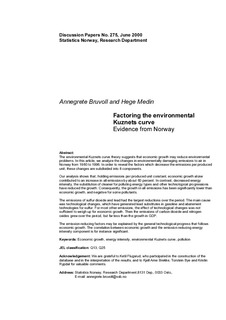Factoring the environmental Kuznets curve evidence from Norway
Working paper

View/
Date
2000Metadata
Show full item recordCollections
- Discussion Papers [1003]
Abstract
The environmental Kuznets curve theory suggests that economic growth may reduce environmental problems. In this article, we analyze the changes in environmentally damaging emissions to air in Norway from 1980 to 1996. In order to reveal the factors which decrease the emissions per produced unit, these changes are subdivided into 8 components. Our analysis shows that, holding emissions per produced unit constant, economic growth alone contributed to an increase in all emissions by about 60 percent. In contrast, decreased energy intensity, the substitution of cleaner for polluting energy types and other technological progressions have reduced the growth. Consequently, the growth in all emissions has been significantly lower than economic growth, and negative for some pollutants. The emissions of sulfur dioxide and lead had the largest reductions over the period. The main cause was technological changes, which have generated lead substitutes in gasoline and abatement technologies for sulfur. For most other emissions, the effect of technological changes was not sufficient to weigh up for economic growth. Then the emissions of carbon dioxide and nitrogen oxides grew over the period, but far less than the growth in GDP. The emission reducing factors may be explained by the general technological progress that follows economic growth. The correlation between economic growth and the emission reducing energy intensity component is for instance significant.
Keywords: Economic growth, energy intensity, environmental Kuznets curve, pollution